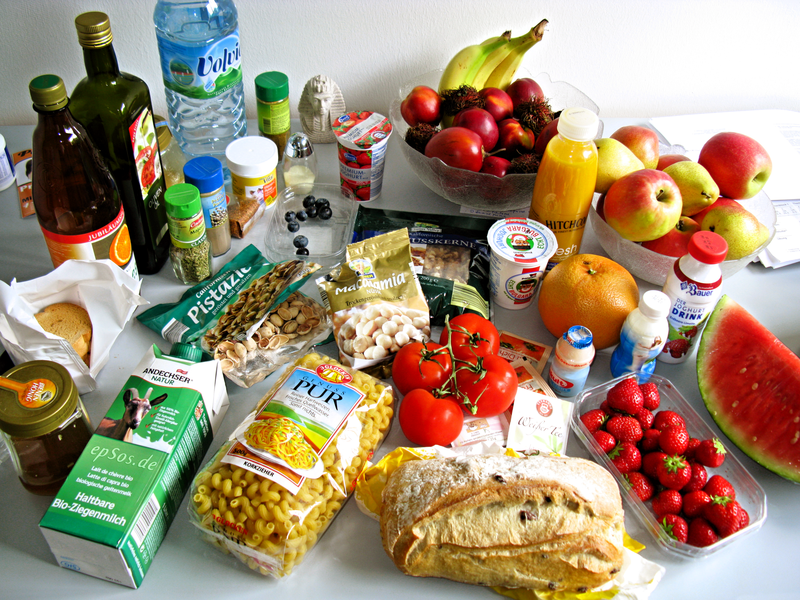English: Free picture of tasty food abundance in the healthy heart of Europe. This tasty photo was created for you by the cooking, best friend epSos.de and it can be used for free, if you link epSos.de as the original author of the image.
The tasty food abundance and the colourful reds of the food are very accessible in Europe, because European people are cooking more often and eating foods that are fresh from around the world.
An easy dinner in europe can be boughts ina ny self-respected supermarket for grocery supplies. Local European food is healthy, if it was cooked fresh and from raw ingredients.
A healthy diet of testy food is very easy and cheap to hav ein Europe. The diversity in the European supermarkets from Germany, Italy, Spain and France is very good. The central location of Europe is very beneficial for the food on the table. The European food basket can contain the taste health from Africa, America and Asia, because all groceries from those continents are relatively easy to ship by air.
The traditional Italian nutrition of organic food is very popular in the world. It is very important to use raw ingredients in the Italian cuisine. Vegetarian ingredients are often colourful and beautiful for ideas, but often fail at calories and nutritional value. The vegan food of the French people is often popular, because it contains fresh fruits and many nuts.
The international bank of reconstruction and development reported that association of Europe was the union of the highest importers of food in 2005, the USA followed on excision and Japan. Now the food changes and put in circulation on the global basis. A variety and availability of food any more aren't limited to an inequality of locally cultivated food or restriction of a local growing season.
Between 1961 and 1999 were available 400 % in the world export of food. Now some countries economically depend on export of food which answers in several ambushes for more than 80 % of all export.
The concept Food encloses as an upper concept the drinking water as well as the food. Drinking water exists of water and in it to relaxed mineral substances.
As opposed to drinking water food exists in the essentials of the macronutrients – this are the carbohydrates, the Lipide (fats) and the proteins – and, hence, supply to the person chemically engaged energy.
In addition, micronutrients as amount elements and trace elements are essential components of food. Food is taken up by the person for the purpose of the nutrition or the consumption over the mouth, if necessary after other preparation.
From juridical view the luxuries count beside drinking water and food as main groups also to the food and tobacco products are excluded.
The nutritional value is the central use of food. It is 1 mA, to qualify the physiological calorific value of a food. Mostly one summarises under the concept Nutritional value only the calorific value, so to the body at the possession energy.
The amount in food rubbish, yearly in 27 member states of the EU, it is estimated in an examination published by the EU commission at approx. 89 million tonnes, up to 50% along the food supplies chain, this corresponds 179 kg per head, with big differences between the single countries and the different branches.
Besides, the waste is not included with the agricultural production or the back throw by catches in the sea yet.
The limited in time prize increase of food is called food price crisis in 2007-2008 between 2007 and 2008.
The prices of four main food rice, maize, wheat and soy bean trebled possibly between autumn, 2005 and in the middle of 2008. In 2007 a quick increase was registered and the prize points were reached in winter, 2007 and spring, 2008. 2013 is another year for price increases.
Full value nutrition calls a nutrition draught with which fresh and untreated food as well as wholemeal products is preferred. The draught is based on the whole foods of Werner Kollath.
Generally usage the concept is used often synonymously to full nutrition and whole foods. Full nutrition is based on the recommendations of the German society for nutrition and calls a mixing food draught with nutrition-medical objective.
By trend food one understands food whose consumption to a fashion-conditioned boom increases after in a certain period strongly or they come on the market generally only anew and differ from the present offer of food.
Nutrition trends are examined by scientists and market researchers for different reasons. Besides, there are only few worldwide uniform trends at the food market; the predilections concerning nutrition in Asia are not identically with those in Europe or in the USA.
Thank you for sharing this picture with your friends !

